#Ford GT40 by Holman-Moody
Text
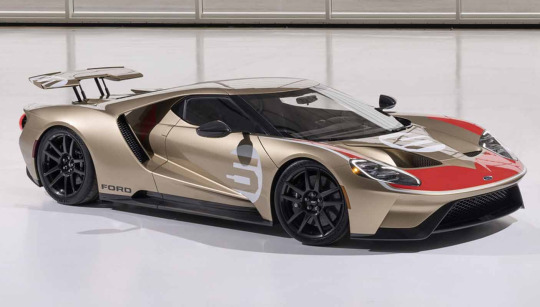
#ford#ford gt#holman moody#heritage#heritage edition#supercar#supercars#car#cars#special edition#fast#fast car#american#american supercar
17 notes
·
View notes
Photo

Ronnie Bucknum / Dick Hutcherson - Holman & Moody (Ford GT40 Mk II #1016) 3ème des 24 Heures du Mans 1966. © Sutton / Motorsport. - source Carros e Pilotos.
56 notes
·
View notes
Text
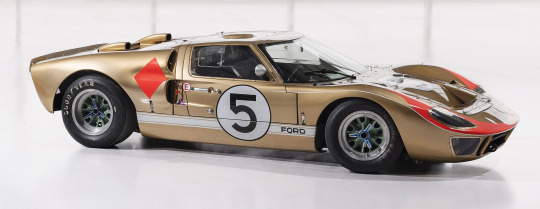
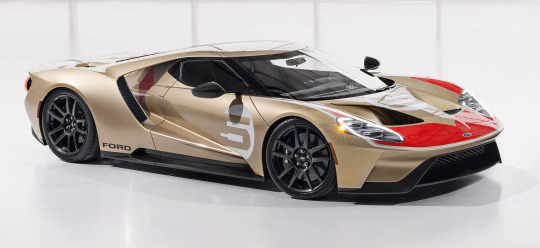

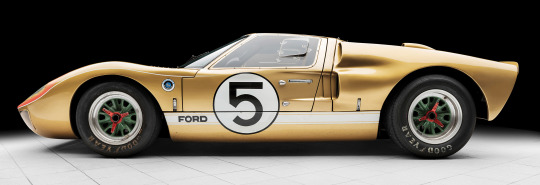

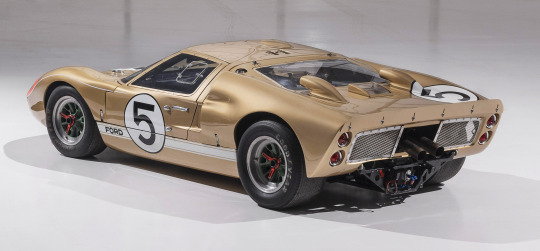
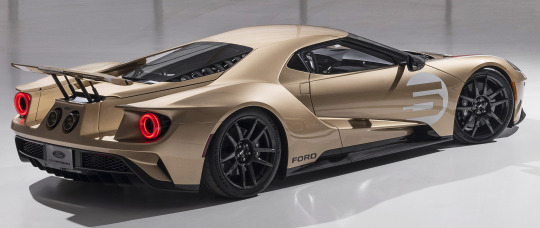
What a difference 56 years makes juxtaposition of Ford GT40 by Holman-Moody. 1966 & Ford GT Holman Moody Heritage Edition, 2022. A limited edition that pays tribute to the GT40 MK II race car that completed the famous 1-2-3 sweep at the 24 Hours of Le Mans in 1966.
#Ford#Ford GT40#Ford GT40 by Holman-Moody#Ford GT Holman Moody Heritage Edition#Ford GT#special edition#limited edition#1966#2022#Le Mans#24 Hours of Le Mans#What a difference#mid-engine
434 notes
·
View notes
Photo
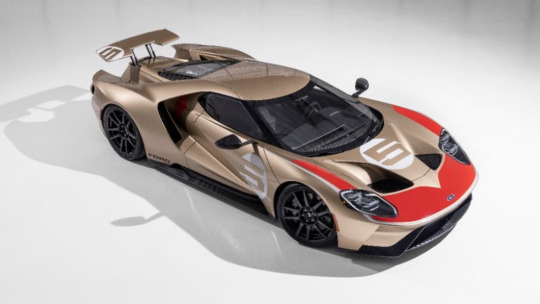
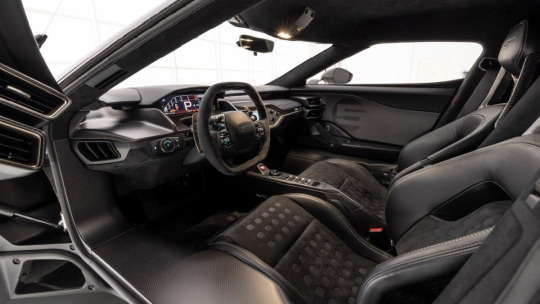
Ford GT Holman Moody Edition to be Revealed in NYC
In a special nod to the debut of the original Ford GT40 prototype at the 1964 New York Auto Show, Ford is returning to the Big Apple for the first public appearance of its new GT Heritage Edition – the 2022 Ford GT Holman Moody Edition. Livery features exclusive Holman Moody Gold exterior paint, contemporary touches of exposed carbon fiber, plus signature Heritage Red and Oxford White accents; first customer deliveries begin this spring.
The 2022 New York Auto Show will open its doors to the public April 15-24 (press days: April 13 &14) at the fully-expanded Jacob K. Javits Convention Center in Manhattan, to kick-start the springtime automotive selling season.
The ultra-limited-production GT Holman Moody Edition supercar will be on display at the 2022 New York International Auto Show side-by-side with the podium-placing Holman Moody Ford GT40 MK II, chassis No. P/1016.
171 notes
·
View notes
Video
Ford GT-X1 wins Sebring in 1966 by Louis Galanos
Via Flickr:
Ken Miles (seen driving) and Lloyd Ruby drove this Ford GT-X1 #GT/110 to a first place finish in the 1966 12 Hours of Sebring. The car was entered by Shelby American and was equipped with a 7-liter V8. A Holman & Moody Ford Mk. II driven by Mark Donohue and Walt Hansgen came in second. The race had some tragic moments when Canadian driver Bob McLean died in a fiery crash at the wheel of a privately entered Ford GT40 and Don Wester, driving a Porsche 906P, trying to avoid a spinning Mario Andretti goes off course killing four spectators. Photo from the Ford racing archives.
#Ford#Ford GT40#Ford GT-X1#Sebring#!966 12 Hours of Sebring#Ken Miles#sportscar#cars#prototype#Ennstal-Classic#auto-racing#motorsports#racing#race#legends#endurance#vintage#SCCA#automobile#heures#Louis Galanos#Nigel Smuckatelli
6 notes
·
View notes
Link
The Ford GT Holman Moody Heritage Edition is the final special edition Ford GT built to commemorate numerous GT40 racing victories.
0 notes
Text
The Ford GT Hallman Moody Edition is the latest Heritage Edition GT
The Ford GT Hallman Moody Edition is the latest Heritage Edition GT
The special edition Ford GT has been wearing the iconic colors of the Hallman Moody GT40 since 1966 and will be on display at the New York Auto Show 2022.
By
Jayveer Mehra
Published: 11-Apr-22 03:06 PM IST
0 Views
Ford Announces Ultimate Heritage Edition GT – Holman Moody Edition Based on the 1966 Hallman capital MkII GT40, the special edition celebrates the carmaker’s iconic 1-2-3 ’66 Le…

View On WordPress
0 notes
Photo

🚨 Ford GT | Holman Moody Heritage Edition | Honors 1-2-3 Ford Sweep at 1966 Le Mans 🏆 | ➡️ Available to only Approved GT customers 🏆 Ford GT Specifications ➡️ 3.5L EcoBoost V6 ➡️ 660 PS ➡️ 746 Nm ➡️ Top Speed: 350 kmph ➡️ 0-100 kmph: 4 sec ➡️ 7-DCT ➡️ RWD ➡️ Do follow @theautomotivetimes.at @fordperformance #theeautomotivetimes #newfordGT #fordGT #Cars #car #dailycars #fordgt40 #gt40 #specialeditioncar #fordperformance #porsche #lamborghini #bmw #mercedesGT #nissanGTR #GTR #skyline #ford #performacecars #coupe #sportscar #racingcar #trackcar #fastestcar #v6 #amazingcars247 #rich #money https://www.instagram.com/p/CcNGLrGLoxI/?igshid=NGJjMDIxMWI=
#theeautomotivetimes#newfordgt#fordgt#cars#car#dailycars#fordgt40#gt40#specialeditioncar#fordperformance#porsche#lamborghini#bmw#mercedesgt#nissangtr#gtr#skyline#ford#performacecars#coupe#sportscar#racingcar#trackcar#fastestcar#v6#amazingcars247#rich#money
0 notes
Text
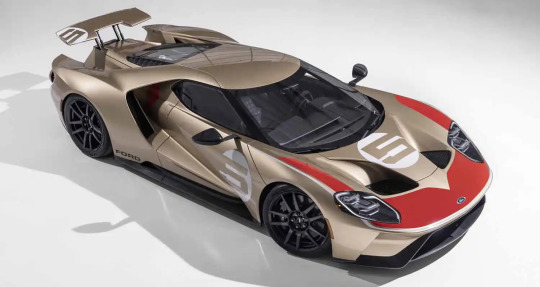
#ford#ford gt#holman moody#heritage#heritage edition#supercar#supercars#car#cars#special edition#fast#fast car#american#american supercar
15 notes
·
View notes
Photo
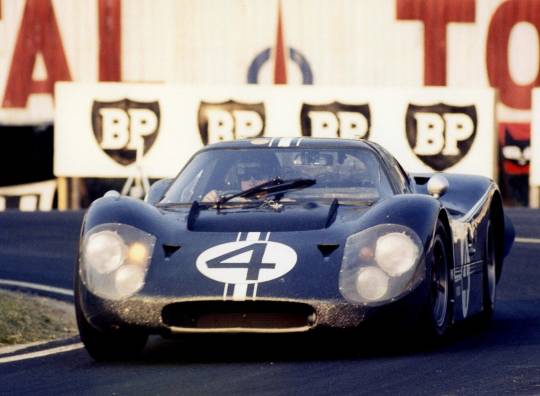
Lloyd Ruby (Holman & Moody - Ford GT40 Mk IV #J8) 24 Heures du Mans 1967. - Carros e Pilotos.
52 notes
·
View notes
Text
Encore une fois à Cuba et mon opinion sur Ford contre Ferrari
Le 4 décembre 2019
Ouf! Pas facile pour un mordu de l’auto comme moi de prendre une semaine de vacances et de ne pas penser aux bagnoles. Surtout si ma destination est Cuba! Le problème est moindre si je me rends à Cayo Largo, petite île au sud de la grande île principale où il n’y a qu’une vingtaine de véhicules. Mais les conséquences sont plus importantes lorsque c’est dans la région de Varadero ou à La Havane où les «belles» anciennes pullulent! Enfin, le mot «belle» ne devrait pas toujours s’appliquer…
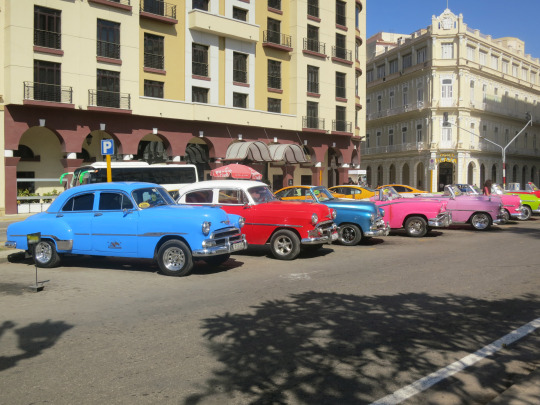
Une brochette de «belles» Américaines au Parque Central de La Havane. (Photo Éric Descarries)
Pour résumer en quelques mots le parc automobile de Cuba, disons qu’il y a plus de 60 000 Américaines des années quarante et cinquante survivant dans l’île (mais pas partout) dont la majorité sont des Chevrolet de 1950 à 1956, cette dernière année étant la plus populaire. Il y a aussi de nombreux taxis Geely, des Peugeot alors que si vous louez un véhicule, il y a de fortes chances que ce soit aussi une Peugeot où, mon préféré, le nouveau Suzuki Jimny que j’aurais bien aimé voir sur notre marché.
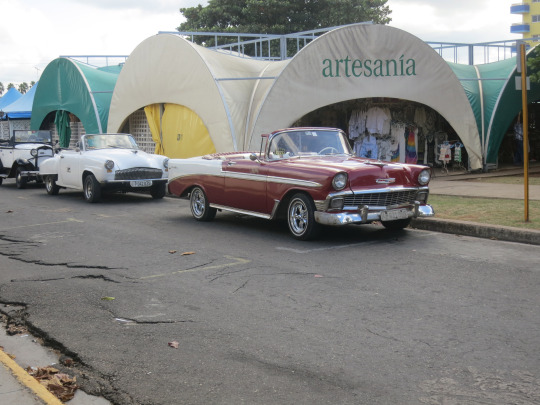
La Chevrolet 1956 fut la voiture américaine la plus vendue des années cinquante (pré-révolution) à Cuba. (Photo Éric Descarries)

Si vous voulez louer une voiture à Cuba, ce sera, soit une Peugeot ou une Geely ou encore un Suzuki Jimny de nouvelle génération. Toutefois, oubliez l’idée de faire du hors-route, il n’y a pas d’endroit approprié pour cela. Qui plus est, il y a de fortes chances que la fonction de quatre roues motrices du Suzuki soit désactivée! (Photo Éric Descarries)
Si vous allez dans les régions de La Havane et Varadero, vous y verrez également quelques voitures récentes et surtout des pick-up GMC Sierra de la dernière génération, ceux-ci appartenant à des compagnies canadiennes qui y exploitent gaz et mines. Ils y ont aussi plusieurs poids lourds International et Freightliner et des Ford F-250.

Il y a beaucoup de camionnettes GMC récentes et de poids lourds International et Freightliner tout aussi récents à Cuba mais rien n’est plus agréable que de voir un vieux camion Ford 1955 restauré sur la route. Celui-ci était un bel exemplaire mais il y a de fortes chances qu’il repose sur un châssis de camion Hino, ou Kamaz (russe) plus récent. (Photo Éric Descarries)
Mon plaisir, c’est d’y photographier des «créations» cubaines dont certaines sont des avants de grosses américaines du début des années cinquante sur un châssis de camionnette avec une carrosserie faite maison dans le but d’en faire un grand Taxi. Chauffeur de taxi personnel, une profession payante à Cuba.

Pour une fois, je suis bouche bée! Je ne saurais vous dire sur quoi est basée cette création locale, sauf qu’une partie de la cabine semble tirée d’une camionnette International des années cinquante! (Photo Éric Descarries)
Notez aussi que sous le capot de la plupart de ces Américaines des années cinquante se cache un moteur diesel à quatre cylindres ayant autrefois appartenu à un camion de livraison japonais ou européen. Les autos ainsi équipées sont reconnaissables à leur gros tuyau d’échappement (qui laisse échapper une fumée noire si la voiture est «nourrie» d’un carburant dit «clandestin») ou au son agaçant du moteur qui n’appartient certes pas aux autos en question.

Cette Jeep ressemble à une TJ récente mais si on l’examine attentivement, il s’agirait plutôt d’une réplique…de source asiatique inconnue. (Photo Éric Descarries)

Il y a plusieurs petites autos anglaises des années cinquante à Cuba dont certaines sont des Ford anglaises comme cette Consul. (Photo Éric Descarries)
Les Chevrolet sont nombreuses car elles se sont beaucoup vendues à cette époque où l’argent était plus courant. Si la Mafia y exerçait une certaine influence, ce n’était pas tant elle qui achetait des autos de luxe que les habitants cubains qui pouvaient se payer des berlines à quatre portes de base.

Les Lincoln sont plutôt rares à Cuba, contrairement aux Cadillac. Toutefois, une Lincoln-Zephyr 1947-48, c’est encore plus rare, même en Amérique! (Photo Éric Descarries)
Si, dans la région de Varadero, il y a tant de cabriolets, regardez-y à deux fois. Plusieurs ont déjà été des coupés ou des berlines auxquels on a coupé le toit, une pratique qui était faisable à cette époque où les autos étaient montées sur des châssis rigides ( ce qui n’est presque plus possible aujourd’hui vu la configuration populaire de caisses autoporteuses).
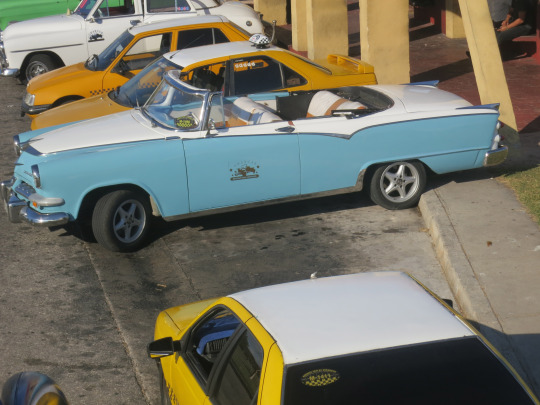
Si certains cabriolets sont des coupés ou même des berlines au toit coupé, cette (rare) Dodge Custom Royal 1956 semble originale. (Photo Éric Descarries)

Ce cabriolet Edsel 1958 est un parfait exemple de voiture dont le toit a été coupé. On le voit par la partie du toit original qui reste juste derrière le haut du pare-brise! (Photo Éric Descarries)
Enfin, si vous croyez pouvoir acheter une vieille bagnole à Cuba et l’envoyer chez vous, préparez-vous à signer un gros chèque comme on a pu le voir à la télé à l’émission de José Gaudet et Guildor Roy. Un cabriolet Chevrolet 1955-56 en «pas pire» état s’y vendait plus de 25 000 $. À ce prix-là, vous en trouverez un superbe exemplaire bien restauré en Amérique du Nord!
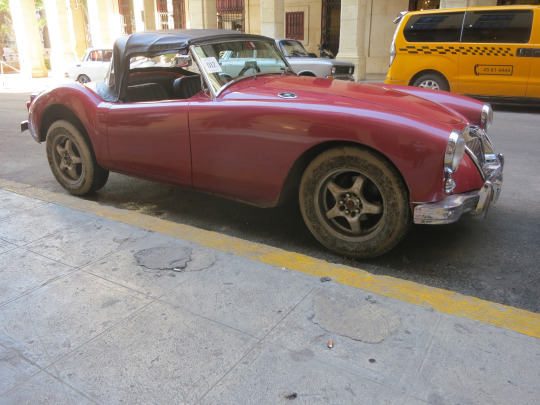
C’est à se demander si cette MG-A n’aurait pas mérité une restauration un peu plus professionnelle…ce qui est presque impensable à Cuba! (Photo Éric Descarries)
Ford contre Ferrari…hummmm!
Le film «Ford contre Ferrari» est toujours en salle au moment d’écrire ces lignes. Plus d’un m’a demandé si je l’avais vu et ce que j’en pensais…
Juste avant de m’envoler pour Cuba, j’ai joint un groupe d’amis dont la majorité était des vrais mordus de l’auto. Le but? Voir ce film et en discuter. Toutefois, avant ce visionnement, j’avais lu des critiques et j’avais entendu certaines remarques à la radio. Toutes étaient unanimes : «must see»! Mais avec un bémol. Si l’on connaissait vraiment l’histoire, il fallait faire fi de celle-ci, c’était un film hollywoodien…
J’ai regardé le film. Soyons honnêtes! Si vous ne connaissez pas la véritable histoire, vous aurez vu un beau film mettant en vedette la véritable amitié entre deux hommes. Mais ce n’est pas la véritable histoire de Ford contre Ferrari. J’ai plus de 70 ans et j’ai vraiment suivi les évènements à cette époque.
Ce que je n’ai pas aimé dans le film, c’est la distorsion de l’histoire. Oui, Ford voulait battre Ferrari. Mais en vérité, Ford, dont le programme de l’époque s’appelait «Total Performance» voulait tout gagner, du Daytona 500 aux 500 Milles d’Indianapolis (Jim Clark 1965) à la Formule Un (plus tard) en passant par le Rallye Monte Carlo (avec Falcon dans sa catégorie en 1964) et j’en passe.
Toutefois, ce n’est pas Carroll Shelby qui a débuté le programme GT40 mais la division anglaise de performance de Ford (Ford Advanced Vehicles) qui a failli en 1964 et 1965. Shelby a mis les Cobra au monde mais son apport à la Ford de Le Mans ne viendra qu’en 1966 avec l’aide de Holman and Moody (NASCAR)…mais cela est trop long à raconter.
Dans le film, Shelby fait peur à Henry Ford II en piste (ce n’est jamais arrivé!), Leo Beebe est un «méchant» (faux!), Ken Miles a un mauvais caractère…(hummm!...vrai!)…seul Phil Remington, le bras droit de Shelby semble réel! Puis, Shel’ mesurait plus de six pieds (je l’ai rencontré au moins cinq fois dans ma vie...c’est vrai!) et non cinq pieds sept pouces comme Matt Damon, l’acteur…
Il y a plusieurs anachronismes dans le film (dont une Cobra Daytona avec des roues de 17 pouces au lieu des 15 pouces de l’époque) mais c’est vrai que Shel’ se déplaçait avec son roadster 289 bleu.
Toutefois, le pire, c’est à la fin du film lorsque Ken Miles prend place à bord de ce que nous savons être le prototype J-Car avec lequel il allait se tuer au bout de quelques tours. Dans le film, il ne s’agit que d’un kit car GT 40 qu’on a légèrement modifié pour ressembler au J-Car (quand même…Hollywood ne manque pas de ressources pour modifier, ne serait-ce que légèrement, une réplique de GT40 en J-Car !) alors que la Mark VI finale n’est qu’une réplique de GT40 avec des «stripes» latérales mal reproduites. J’ai vu suffisamment de superbes répliques de MK-IV que Hollywood aurait pu en louer une au lieu de mal maquiller un kit car! Quentin Tarantino n’a fait aucune de ces erreurs chronologiques dans son film «Once upon a time in Hollywood!»!
Oh! C’est vrai que Henry Ford II était à la victoire des trois MK II aux 24 Heures de 1966 (et il y pleuvait, pas comme dans le film!) mais Enzo Ferrari? Non! Je pourrais continuer longtemps comme cela mais à la place, puis-je vous suggérer un livre (en anglais) sur la véritable histoire de la victoire de Ford en 1966? C’est «Ford versus Ferrari» de John Starkey que j’ai trouvé chez Chapter’s à Dorval pour la modique somme d’environ 25 $. Il est plus en image qu’en texte. Facile à lire ou à consulter! Sinon, il y a plusieurs autres livres expliquant la victoire de Ford sur le marché dont Go Like Hell. Hélas, je n’ai rien en français sauf le vieux tirage de «Le Duel Ford-Ferrari» des Éditions Marabout des années soixante.
Qu’importe, je trouve triste que l’on ait déformé cette merveilleuse histoire à ce point. Le film est «le fun» à regarder mais si l’on en connaît vraiment l’histoire, on ne s’y reconnaît pas. «Oscarisable»? Non! «Cars» (Bagnoles) en dessin animé y était plus crédible. OK, le film n’était pas destiné à des mordus de l’histoire automobile comme moi. Mais pourquoi ne pas y avoir apporté plus de détails?

Le livre Ford Versus Ferrari de John Starkey (avec plusieurs superbes photos historiques) vous donnera la véritable histoire de la lutte que le constructeur américain a menée contre le légendaire Italien… (Photo Éric Descarries)
1 note
·
View note
Video
1966 Daytona 24 - William Wonder GT40 by Louis Galanos
Via Flickr:
William Wonder and Herb Wetanson drove this Ford GT40 (chassis #GT/103) at the 1966 Daytona 24. The car failed to finish due to a broken wheel. The 1966 Daytona 24 was the first 24 hour race at the Daytona International Speedway. The race was won by Ken Miles and Lloyd Ruby driving a Shelby Ford Mk II with Dan Gurney and Jerry Grant coming in second in another Shelby Ford Mk.II. A Holman & Moody Ford Mk. II would finish third with Mark Donohue and Walt Hansgen driving. Please note that the rear fender flares have been cut to form a larger opening. On the 31 degree high banks the centrifiugal force caused the car bodies to be forced down onto the tires necessitating alterations to the suspension and body. Stan Rosenthall photo.
2 notes
·
View notes
Video
Volvo and Ford GT40 at Daytona in 1966. by Louis Galanos
Via Flickr:
Going into turn one at Daytona in 1966 is the Ike Maxwell, William J. Martin Volvo P1800 folowed closely by the Mark Donohue, Walt Hansgen Ford GT40 Mk. II entererd by Holman & Moody. The Ford would finish 3rd overall while the Volvo finished 21st. Al Bochroch photo.
1 note
·
View note
Text
Ford v ferrari
Sinopsis Pada tahun 1963, wakil presiden Ford, Lee Iacocca (Jon Bernthal), menyarankan kepada Henry Ford II (Tracy Letts) untuk membeli Ferrari yang pailit sebagai sarana untuk meningkatkan penjualan mobil mereka dengan berpartisipasi dalam Le Mans 24 Jam. Akan tetapi, Enzo Ferrari (Remo Girone) membatalkan kesepakatan tersebut karena Fiat menawarkannya kesepakatan yang lebih menguntungkan, yang memungkinkannya untuk mempertahankan kepemilikannya atas Scuderia Ferrari. Ketika ia menolak kesepakatan yang diajukan oleh Ford, Enzo Ferrari menghina perusahaan dan pemimpinnya. Henry Ford II yang marah mendirikan divisi balap sendiri untuk membuat mobil demi mengalahkan Scuderia Ferrari di Le Mans. Atas perintah ini, Lee Iacocca mempekerjakan pemilik Shelby American, Carroll Shelby (Matt Damon), seorang mantan pembalap yang memenangkan Le Mans pada tahun 1959 tetapi terpaksa pensiun karena kondisi jantung. Selanjutnya, Carroll Shelby meminta bantuan Ken Miles (Christian Bale), seorang mekanik dan pembalap Britania Raya yang pemarah dan keras kepala. Carroll Shelby dan Ken Miles menguji prototipe Ford GT40 Mk I di Bandar Udara Internasional Los Angeles, mengerjakan semua kelemahan desainnya hingga siap untuk balap. Melihat bahwa Ken Miles bukan pembalap ideal mereka, Henry Ford II memilih untuk mengirim Phil Hill (James Tyler Paulson) dan Bruce McLaren (Benjamin Rigby) ke Le Mans 1964 sebagai gantinya. Seperti yang diperkirakan oleh Ken Miles, tak satu pun pembalap Ford yang menyelesaikan pertandingan balapnya. Ketika Henry Ford II melihat hal ini sebagai kekalahan yang memalukan, Carroll Shelby menjelaskan kepadanya bahwa Ford GT40 membawa rasa takut pada Enzo Ferrari karena mencapai 218 mil per jam di Mulsanne Straight sebelum mobil itu mogok. Carroll Shelby dan Ken Miles melanjutkan pengembangan pada Ford GT40 Mk II, tetapi Ken Miles hampir terbunuh ketika rem mobil gagal selama pengujian. Pada tahun 1966, eksekutif senior wakil presiden Ford Leo Beebe (Josh Lucas) mengambil alih divisi balap dengan maksud untuk melanjutkan program tanpa Ken Miles, tetapi Carroll Shelby memberikan Henry Ford II tumpangan di mobil balap itu dan bertaruh dengan perusahaannya sendiri untuk meyakinkan Henry Ford II agar setuju bahwa Ken Miles diizinkan berpartisipasi dalam pertandingan balap Le Mans jika ia memenangkan Daytona 24 Jam. Shelby American berpartisipasi dalam pertandingan Daytona, tetapi Leo Beebe memiliki Ford kedua yang dimasukkan dengan tim NASCAR Holman-Moody yang mendukungnya. Ketika tim Holman-Moody berhenti terlalu dini, Carroll Shelby meminta Ken Miles melampaui batas kecepatan mobilnya menjadi 7.000 rotasi per menit hingga ia memenangkan pertandingan. Di Le Mans 1966, Ken Miles berusaha mengurus pintu mobilnya yang tidak bisa tertutup rapat selama putaran pertama, tetapi setelah insinyur tim Phil Remington (Ray McKinnon) memperbaikinya dengan palu, Ken Miles mulai mencatat rekor putaran sambil mengejar tim Ferrari. Ketika ia mengejar pembalap Ferrari Lorenzo Bandini (Francesco Bauco) – mengemudikan prototipe baru Ferrari 330 P3 – Ken Miles mengalami kegagalan rem dan mengganti sistem remnya selama pit stop. Enzo Ferrari memprotes langkah itu, tetapi Carroll Shelby meyakinkan panitia pertandingan balap bahwa penggantian itu sah menurut buku aturan pertandingan. Ken Miles dan Lorenzo Bandini berduel sekali lagi di Mulsanne Straight hingga Lorenzo Bandini merusak mesinnya, menghilangkan Ferrari dari balapan. Dengan tiga tim Ford berada di posisi teratas, Leo Beebe memerintahkan Carroll Shelby untuk membuat Ken Miles melambat agar dua Ford lainnya dapat menyusulnya dan memberikan sebuah foto tiga mobil bersama di garis akhir untuk pers. Ken Miles awalnya menentang keputusan ini dengan tetap membuat rekor putaran baru mendekati akhir pertandingan, tetapi ia memutuskan untuk membiarkan Ford lain berada di putaran terakhir. Pada akhirnya, Bruce McLaren dinyatakan sebagai pemenang secara teknis, tetapi Ken Miles berterima kasih kepada Carroll Shelby karena memberinya kesempatan untuk balapan di Le Mans. Dua bulan setelah Le Mans, saat menguji J-car di Riverside International Raceway, Ken Miles sekali lagi mengalami kegagalan rem dan terbunuh dalam kecelakaan yang terjadi. Enam bulan kemudian, Carroll Shelby mengunjungi istri Ken Miles, Mollie (Caitriona Balfe), serta putranya, Peter (Noah Jupe), dan memberi Peter kunci pas yang diberikan Ken Miles kepadanya sebelum memenangkan perlombaan Sports Car Club of America di Willow Springs pada tahun 1963. Ford melanjutkan kemenangannya di Le Mans pada tahun 1967, 1968 dan 1969. Ken Miles secara anumerta mendapatkan Motorsport Hall of Fame of America pada tahun 2001. Angle camera: High angle:saat mat miles mau balapan Low angle:saat mat miles sedang balapan di dalam mobil Frog angle: saat shalby di rawat di rumah sakit karena kena serangan jantung Extreme long shot :saat shalby sedang memperhatikan mat miles sedang balapan Pemeran: Matt Damon Christian Bale Caitriona Balfe Jon Bernthal Tracy Letts Josh Lucas Noah Jupe Remo Girone Ray McKinnon Tanggal rilis: 30 Agustus 2019 (Festival Film Telluride) 15 November 2019 (Amerika Serikat) Durasi:153 menit[1] Negara:Amerika Serikat
0 notes
Link
Při vítězné jízdě Bruce McLarena a Chrise Amona nebyl Ford v závodě 24 hodin Le Mans v roce 1966 jedinou zúčastněnou americkou značkou. Jejich slavný černý GT40 Mark II totiž ujížděl na pneumatikách Goodyear – i když do závodu nastoupil na gumách velkého soupeře Goodyearu v tzv. válce pneumatik, společnosti Firestone.
„Vítězství McLarena a Amona dokonalo tah značky Goodyear na místa na stupních vítězů a stalo se naším druhým triumfem na Le Mans za sebou,“ vysvětluje Mike Rytokoski, viceprezident a ředitel marketingu společnosti Goodyear v Evropě. „V Goodyearu jsme stále velice hrdí na to, že jsme v této historické události motoristického sportu sehráli tak klíčovou roli. A jsme rádi, že můžeme tento odkaz uctít oznámením partnerství s filmem Le Mans ‘66.“
Hvězdami filmu Le Mans ’66 jsou držitelé Oscara Matt Damon a Christian Bale. Snímek přibližuje pozoruhodný pravdivý příběh vizionářského amerického konstruktéra vozidel Carrolla Shelbyho (Damon) a neohroženého britského řidiče Kena Milese (Bale), kteří se spolu vydali do boje proti fyzikálním zákonům i svým osobním problémům, aby pro Ford Motor Company stvořili revoluční závodní vůz a svrhli na 24 hodin Le Mans ve Francii v roce 1966 z trůnu do té doby bezkonkurenční závodní vozy Enza Ferrariho.
Závod 24 hodin Le Mans v roce 1966 začal za deštivého počasí a brzy se jasně ukázalo, že to svědčí spíše pneumatikám Goodyear než Firestone. Zatímco první dva zúčastněné vozy Shelbyho amerického závodního týmu – číslo jedna Kena Milese a Dennyho Hulmeho a číslo 3 Dana Gurneyho a Jerryho Granta – netrápily na pneumatikách Goodyear žádné problémy, z McLarenových pneumatik Firestone se začaly na dlouhé rovince Les Hunaudières při rychlosti přes 338 km/h odlamovat kousky běhounu.
Zdroj: Goodyear
Po dojezdu do depa, kde předal řízení Amonovi, proto McLaren vyhledal zástupce Firestonu a vyjednal s ním, aby mohl přejít na značku Goodyear. Když se pak závod druhého dne dojížděl, zbývající Fordy s číslem 2, 1 a 5 – posledním z nich byl vůz Holman & Moody Ronnieho Bucknuma a Dicka Hutchersona – se seřadily, aby dojely do cíle společně.
O vynuceném stejném vítězném čase obou Shelbyho vozů se dodnes vedou diskuse, záznamy však hovoří jasně o tom, že vítězství bylo nakonec přičteno McLarenovi a Amonovi, protože startovali ze vzdálenější pozice a museli tak za stejný čas ujet delší vzdálenost. Kdyby ovšem včas nepřešli na pneumatiky Goodyear, žádný spor by ani nemohl vzniknout.
V následujících letech Goodyear shromáždil celkem 14 vítězství ve 24 hodin Le Mans a stal se závodním velikánem s 368 vítězstvím ve Velké ceně Formule 1 – což je rekord, který se dosud nikomu nepodařilo překonat.
0 notes
Text
10 Hugely Interesting Vintage Racers from the 2018 Le Mans Classic
The biennial Le Mans Classic has celebrated the rich history of the 24 Hours of Le Mans endurance race since 2002. Like the contemporary 24-hour race, the main event runs through the night, in this case from 4 p.m. on Saturday to 4 p.m. on Sunday, and a 400-plus-strong field is spread over six groups that run three sessions of roughly 45 minutes long each. The cars that star in the main event cover the period from 1923 to 1981, although supporting programs have expanded over the years to include a Saturday race for Group C and GTP cars, which stretches the history to 1993. This year, the addition of the Global Endurance Legends series saw the period now cover virtually to the present day, while Porsche’s 70th anniversary celebration played a central role, which including a dedicated race. Here are 10 of the cars we found most interesting from the more than 500 we saw on track or on display in the paddock:
Toyota GT-One
This year Toyota finally scored the company’s first outright victory in the 24 Hours of Le Mans. The Japanese manufacturer came achingly close at many occasions, usually missing out because of bad luck. That was certainly the case in 1999 when Toyota fielded three examples of the fabulous GT-One. Powered by a twin-turbo V-8, it was the among the fastest cars during that race until several tire failures thwarted the charge. Gifted to designer Andre de Cortanze, this is the only example in private hands and was wheeled out for the Global Endurance Legends showcase by its recent new owner. In period, it had qualified on pole position only to crash out after a high-speed puncture at one of the fastest parts of the track.
Porsche 911 ST
It’s hard to imagine a GT class in practically any race series these days that does not feature a Porsche 911. However, it would take several years after the road cars launched before the German manufacturer started producing factory competition versions of the 911. Among the earliest racers were the 911 ST models built in the early 1970s. With the ST undergoing continuous development, no two examples were quite the same. The car that was raced this year in the Porsche Classic race was built specifically for the 1970 Tour de France with Gérard Larrousse at the wheel. Porsche initially intended to race a sports prototype, but after inspecting the roads some time prior to the event decided a road-car-based racer would be more suitable. Stripped down to its bare bones, it weighed less than 1800 pounds, making it the lightest 911 racing car ever. When Porsche showed up for the actual race, the German company was mortified to find that the entire route had just been resurfaced, which conveniently provided the advantage to the French Matra prototypes, which duly finished first and second. Larrousse finished third, probably much closer to the Matras than a road car should have been. Fittingly, the French ace was reunited with his old ST for the Porsche race.
Ford GT40 MkII
One of the most important cars that took part in the main event this year was the actual Ford GT40 MkII that won the 1966 24 Hours of Le Mans outright, scoring the first overall victory for the Blue Oval. After disappointing results in 1964 and 1965, Ford supported no fewer than eight GT40s in 1966, which were entered by several teams. This car was built to big-block MkII specifications and was entered by Holman & Moody for ‘Kiwis’ Bruce McLaren and Chris Amon. Ford finally managed to beat Ferrari in 1966 with its one-two-three victory. To drive the point home, the cars were brought together as they crossed the finish line for a picture-perfect ending, just as Ferrari did a few months earlier at Daytona. As a twist, the car that crossed the line in second was ultimately declared the winner as it had started further down the order and thus had covered the most distance. There was additional confusion later over which car was the winner, as Ford painted several MkIIs in the Le Mans winner for publicity reasons. As a result, this example—the actual winning car, by the way—was sold off and spent many years hidden away in a Belgian shed. It was eventually discovered and is today in the caring hands of American vintage racer and NASCAR team owner Rob Kauffman, who was brave enough to race the priceless machine at Le Mans once more.
Peugeot 905
Group C cars have achieved a mythical stature for many sports-car-racing enthusiasts. Raced between 1982 and 1993, the original breed of Group C cars had relatively few restrictions, with a limited fuel supply providing the balance between the different cars. A second generation of Group C cars was introduced in the early 1990s with 3.5-liter engine regulations that were similar to those for Formula 1. Most historians make the point that this was a cynical plan on the part of the governing body to lure the many manufacturers active in Group C back to Formula 1. That was certainly the case with Peugeot but before it moved on, the team scored two Le Mans wins with the glorious V-10–engined 905s. Hugely complicated to run and incredibly fast, they are a very rare sight. Yet this year’s Group C race featured not one, but two of the machines, marking in all likelihood the first time a pair have raced together since Le Mans in 1993. Run by French specialists Equipe Europe, the cars now benefit from more modern engine management that allow the V10s to run a little better and longer. This was developed—probably at no small cost—by Oreca. Peugeot’s subsequent spell as an engine supplier in Formula 1 was an utter disaster, with the V-10 universally hated by the teams that ran it.
Talbot 105 Team Car
Before World War II, the 24 Hours of Le Mans was dominated for lengthy periods by single makes, including Bentley in the late 1920s and then Alfa Romeo in the first half of the 1930s. Not among them was the British marque Talbot, but the 105 racers built between 1931 and 1934 are today among the fastest prewar cars to compete in vintage racing. In period these six-cylinder cars were bodied, prepared, and fielded by Fox & Nicholl. The ‘Team Cars’ were liveried in a striking green color and were commonly referred to by their registration numbers. Although they could do no better than third at Le Mans, they were hugely successful elsewhere, including at Brooklands and in the Alpine Trial road rally. Today these cars are raced with great verve by a group of mostly British enthusiasts and the first class—or plateau—that covers cars from 1923 to 1929 was won by one of the Talbots. The other amusingly often lit up the inside rear tire on acceleration.
Team Joest Porsche 956
Well over a dozen examples of the Porsche 956 and 962 were at Le Mans during the Classic weekend but the one that is perhaps the most inconspicuous was the most interesting. This was the ex-Team Joest Porsche 956B that was displayed in a special section dedicated to competition Porsches. Built as one of the final customer cars, it was raced extensively by Team Joest and in fact may be the single most successful Group C car of all. It won at Le Mans in 1984 with Klaus Ludwig and Henri Pescarolo at the wheel when the works team decided to skip the race. If that wasn’t impressive enough, it won again the following year with Ludwig joined this time by Paolo Barilla and Louis Krages, a.k.a. “John Winter.” This time, crucially, the works team was out in force with three examples of the brand new 962C. This would not be the last time that Joest would best the factory team with a customer car, but Reinhold Joest cherished this example—the only Group C car to win Le Mans twice—and displayed it for many years in his private museum. He only sold the car last year to the current British custodian, who has a formidable selection of sports racing cars.
Ferrari 250 LM
With values going through the roof these days, it is increasingly rare to see a “run-of-the-mill” Ferrari race in historic events. Rarer still is to see one of the fewer than three dozen 250 LMs being raced with great verve. Fortunately, there is one enthusiast who campaigns his eight-figure machine and also entrusts it to professional racers. During the night session we even spotted glowing discs on the ex-Maranello Concessionaires example. Finished in striking red and “Cambridge Blue” colors, this 250 LM was raced by the likes of Graham Hill, Jo Bonnier, and Denny Hulme in period. It was later part of some of the most formidable classic-car collections in the world. We’re lucky that it’s now in just the right pair of hands.
It can be hard to remember that deep under the flared wheel arches and ultra-wide body panels of a Porsche 935, there is in fact a Porsche 911 hidden away—a 911 Turbo to be precise. These silhouette racers dominated the GT class from the second half of the 1970s and even scored numerous outright wins, including at Le Mans in 1979. Many variants of these cars took to the track at Le Mans, including the wild ‘K3’ variant built by the Kremer Brothers. (It was this type that scored that ’79 victory.) Also out on track was one of just two works cars that are in private hands. Restored by Porsche specialist Manfred Freisinger, this Martini-liveried car was driven by current works driver Romain Dumas, who had just two weeks earlier set a new outright record at the Pikes Peak hill climb. Usually belching out big flames on the overrun, the big yet deceivingly fast 935s were among the most spectacular cars in action during the weekend, and their legend is such that Porsche recently announced a limited series of new 935s based on the current GT2 RS.
Lola T600
The cutoff year for the sixth and final plateau of classic 24 Hours cars is 1981, the year before the new Group C regulations came into effect. Desperately short on entries in what would be the final year for the current regulations, the organizers were a little more lenient in 1981. Among the cars allowed in was the brand-new Lola T600, which had been built to the new GTP regulations devised by IMSA in the United States but for all intents and purposes was a Group C car. It boasted superior ground-effect aerodynamics and was allowed to run a slightly larger engine than the regular Group 6 prototypes. It really was surprising that it took until this year for one of these cars to make an appearance at Le Mans Classic. Raced at Le Mans in period, the Cosworth V-8–engined machine looks like a rocket ship on wheels. For a variety of reasons, this one could not quite vie for victory in its group but we understand a second one is currently being prepared, which should be even quicker still.
Porsche 917
One of the most mythical of all Porsches, the 917 made history by scoring Porsche’s first two outright victories at Le Mans, in 1970 and 1971. The winning cars, however, looked little like the original 917s of 1969, which had a very bad reputation. Porsche chief engineer Ferdinand Piëch cared only about top speed on the long straights and this made those earlier cars absolutely terrifying to drive, as the lift at high speeds caused them to wander from left to right and be virtually uncontrollable. Their reputation was such that most factory drivers refused to drive the cars, so one of the 917s entered in 1969 was actually driven by gentleman racer John Woolfe. Sadly, he was involved in a fiery crash on the opening lap that cost him his life. After 1969, all 917s were updated with revised bodywork that made them more stable and ultimately hugely successful. A British enthusiast acquired what was left of and the title to the John Woolfe car and had it rebuilt to its original specification, and the car was entered at the Le Mans Classic almost 50 years after that tragic day. Unfortunately, it was crashed once more. There was a second 1969-specification 917 entered as well (it was prepared by Freisinger), and Porsche factory driver Dumas reported many of the same drivability issues as his predecessors did back in ’69.
0 notes